THE RELATIONSHIP BETWEEN GDP AND EMPLOYMENT
INTRODUCTION
Over the past two years there has been significant interest in the relationship between movements in economic activity represented by GDP growth and movements in the labour market represented by employment growth. In particular, commentators were interested in the ongoing strength in the labour market relative to the weaker movements in GDP.
This article is a condensed version of the article published in the June quarter 2005 issue of Australian National Accounts: National Income, Expenditure and Product (cat. no. 5206.0). It describes the relationship between GDP and employment with a particular focus on the way in which movements in time series are analysed and the historical relationship between the variables. Some thoughts as to the nature of the relationship between the two series are also provided, although no definitive explanation of the pattern observed over the past two years is given.
THE ANALYSIS OF TIME SERIES
Estimates of GDP indicate that the growth rate of the economy slowed in the period December 2003 to March 2005, while estimates from the Labour Force Survey shows the labour market grew strongly over the same period. In order to understand the relationship between these series it is important to consider measures of the trends in the series rather than focus on individual quarter on quarter movements. A turning point in the growth rate for the trend series will give an idea as to the underlying direction of the series. The focus in this article is on short term turning points in growth rates rather than longer term business cycle analysis.
The ABS compiles trend estimates using a moving average of seasonally adjusted estimates with Henderson weights. It has been demonstrated that the trend series derived by the ABS is a good estimate of the short term trend movements for any particular series. The method used has the strong advantage of identifying the correct location of turning points. For aggregate series such as GDP and total employment, the turning points are stable over time in that they do not tend to move on the basis of additional information.
Graphs 1 and 2 show the trend movements in GDP and employment up to June 2005. They show a peak in GDP growth in December quarter 2003 and a peak in employment growth in December quarter 2004.
1. GDP, Volume measure - Quarter on quarter trend movements
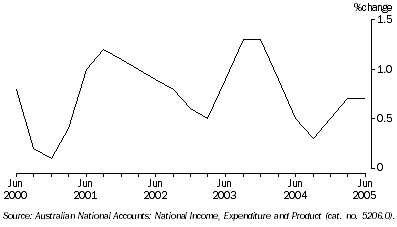 2. Employment, Month on month trend movements
2. Employment, Month on month trend movements
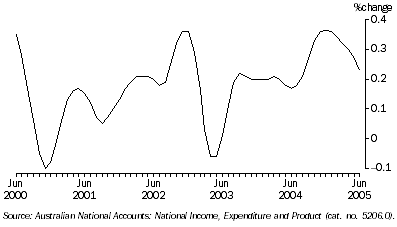
There are a range of other methods by which analysts examine time series. A common method, but not one supported by the ABS, is to derive a time series of seasonally adjusted growth rates in 'through the year' terms. This series is estimated by dividing the current quarter seasonally adjusted estimate by the corresponding estimate from the same quarter of the previous year.
The implied turning points using this method are noticeably later than those estimated using trend estimates. Indeed, it can be shown that the identification of turning points in growth rates using 'through the year' methods will be roughly two quarters after the turning point defined using trend methods such as the Henderson method used by the ABS. The fact that the 'through the year' seasonally adjusted growth in employment had not turned in June 2005 may be one reason for the concern that the employment and GDP estimates appear to be telling different stories about the economy. From our trend analysis, both series have had turning points in their growth rates in the last two years and show a typical lagged relationship between employment growth and GDP growth. The historical nature of this relationship is examined in the next section.
HISTORICAL RELATIONSHIP
The most recent lag between employment and GDP growth turning points of four quarters in the given period is not unusual in an historical context. Work by the ABS in 2004 (Australian Economic Indicators, April 2004) showed that the strongest correlation between GDP and employment growth occurred after three quarters, followed closely by lags of two quarters and four quarters. Based on the latest analysis, the strongest correlation between GDP and employment growth occurred after two quarters, but with strong correlations, also evident after three and four quarters. This work and other analysis suggest that while the nature of the relationship between the two variables changed over time, both in terms of length of the lag and the strength of the correlation, a lag of four quarters, as seen in the most recent cycle, was not a particularly unusual outcome.
A further understanding of the nature of the historical relationship between GDP and employment can be obtained by examining the historical pattern of growth in GDP per hour worked - 'labour productivity'. Graph 3 shows that growth in hours worked and growth in employment are closely correlated. Given this close relationship, it is likely that, during the lags between peaks in GDP growth and employment growth, negative labour productivity growth will occur. Graph 4 and table 5 show recent cycles when negative labour productivity growth was evident. The run of four negative quarters is not unusual and the average size of the negative movement is only slightly larger than other recent runs of negative labour productivity growth.
3. Hours worked and employment, Quarter on quarter trend movements
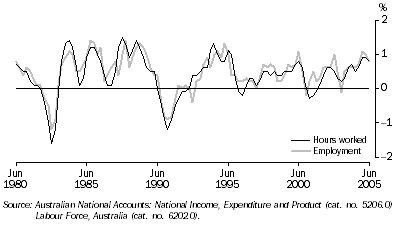 4. GDP per hour worked, Quarter on quarter trend movements
4. GDP per hour worked, Quarter on quarter trend movements
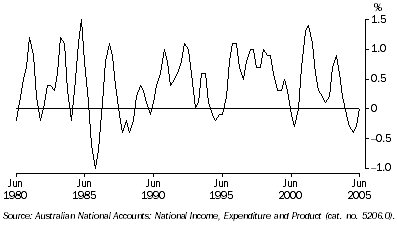
5. Labour productivity |
|  |
 |  | Average percentage change |  |
| Periods of negative labour productivity | Number of negative quarters | GDP per hour worked | GDP | Hours worked |  |
|  |
| Jun 04 to Mar 05 | 4 | -0.3 | 0.5 | 0.7 |  |
| Jun 00 to Dec 00 | 3 | -0.1 | 0.4 | 0.5 |  |
| Sep 94 to Jun 95 | 4 | -0.1 | 0.8 | 0.9 |  |
| Dec 87 to Dec 88 | 5 | -0.3 | 1.0 | 1.2 |  |
| Dec 85 to Jun 86 | 3 | -0.8 | 0.2 | 1.0 |  |
|  |
| Australian National Accounts: National Income, Expenditure and Product (cat. no. 5206.0). |
POSSIBLE ECONOMIC EXPLANATIONS
The existence of a lag between GDP and employment growth can be explained in broad terms. Initially, when a firm looks to increase production it is likely to do so by making more use of its current employees. It is only when it is clear that the increase in production will continue that extra employees will be taken on. This lag reflects costs of training, incorporating new employees into a firm and the time it takes to employ extra people. The reverse is also true when a fall in production occurs. It is only when such a fall is considered more permanent that shedding of labour would occur. While this broad explanation provides a starting point there are many factors that may affect the length and depth of the relationship at any particular point in time. The following section highlights several factors that are considered to be influencing the most recent cycle.
The first factor considered is the impact of the terms of trade. The growth in the terms of trade (measured as the growth in export prices relative to import prices) over the past two years has been very strong. The current rates of growth have only been matched in the 1970s. One impact of an increase in the terms of trade is to give greater purchasing power to Australian producers. While GDP does not take this change in purchasing power into account, a measure of GDP adjusted for the terms of trade effect, Real Gross Domestic Income (RGDI), can be compiled. Since March 2004 RGDI has been greater than GDP reflecting the recent growth in the terms of trade.
Preliminary modelling work by the ABS suggests that a distinct positive impact can be seen between an improvement in the terms of trade and improvements in GDP and employment, with the impact on employment being stronger. Further, although the terms of trade effect has only had a significant impact at certain times over the last 25 years, analysis suggests that there is a persistent impact from the terms of trade over the full time series.
The other factor considered is the impact of real unit labour costs. Graph 6 shows an index of real unit labour costs over the past 25 years. After a strong fall during the 1980s real unit labour costs growth was flat through the 1990s. Since 2001 real unit labour costs have declined steadily with some flattening in the trend in the last 12 months. One explanation of the nature of the lag between GDP and employment growth in the most recent cycle of the period is that relatively low growth in real unit labour costs has allowed employers to continue to hire staff even though growth in output volumes has declined. Only during the run of negative labour productivity growth in 1987-88 was the growth in real unit labour costs lower than during the most recent cycle.
6. Real unit labour costs non-farm, Index (1986-87 = 100.0)
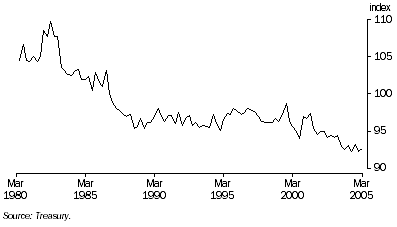
Preliminary modelling work shows a distinct negative relationship between movements in labour costs and growth in employment and GDP with the impact on employment again being stronger. There seems reasonable support for the notion that relatively low real unit labour costs helped to maintain employment growth following the peak in GDP growth in December quarter 2003.
There are a range of other explanations that might help in understanding the relationship between GDP and employment. The nature of the labour market, including the skills sets of recently employed people, the low levels of unemployment and concern over skills shortages, may be one contributing factor. It may also be that when peaks and troughs in trend GDP are relatively moderate, as had been the case in the most recent period, then the strength of the relationship between changes in GDP and changes in employment may be reduced.
Overall, this high level analysis supports the explanation that the combination of strong terms of trade growth and relatively small growth in real unit labour costs during the relevant cycle means that employment would grow relatively strongly compared to GDP. Further analysis and modelling of data is underway to expand our understanding of the issues. An article containing the results of this additional work will be released in the coming months.
POSSIBLE REVISIONS TO GDP
The possibility of revisions to GDP growth rates has led some commentators to conclude that the observed lag between GDP and employment growth would be reduced over time as the GDP estimates are revised. While it is quite likely that GDP would be revised, and indeed revisions to the quarters in the cycle have already been published, the extent of revision required to fundamentally affect the currently published relationship between GDP and employment growth rates would be extreme. A more general revisions analysis is underway, but based on past studies the average revision to seasonally adjusted quarterly movements in GDP is less than 0.1 percentage points. The revision to trend movements is even smaller. Revisions of this magnitude to recent quarters would not be sufficient to move the location of the turning point in GDP growth rates in December quarter 2003.
CONCLUSION
The relationship between GDP and employment can be affected by many factors. As a starting point for analysis it is important to understand the underlying behaviour of the data. The use of Henderson trends as compiled by the ABS is a more appropriate method of understanding these behaviours and turning points than analysing seasonally adjusted data in 'through the year' terms.
The analysis concludes that the latest turning points in GDP and employment growth rates for the period December 2003 to March 2005 can be defined, with the lag being four quarters. This is a slightly longer lag than on average but it is well within reasonable bounds. Two particular factors, strong growth in the terms of trade and relatively weak growth in real unit labour costs, seem to be contributing to the slightly longer than average lag but further analysis of the impact of these and other factors is required.
FURTHER INFORMATION
For further information on the analytical, statistical and technical issues discussed in this article please refer to the original article, published in Australian National Accounts: National Income, Expenditure and Product (cat. no. 5206.0), available at: <https://www.abs.gov.au> (AusStats).
REFERENCES
Australian Bureau of Statistics (April 1991), Picking Turning Points in the Economy, Australian Economic Indicators (cat. no. 1350.0), Canberra.
Australian Bureau of Statistics (August 2003), A Guide to Interpreting Time Series - Monitoring Trends (cat. no. 1349.0), Canberra.
Australian Bureau of Statistics (April 2004), Leading Indicators of Employment, Australian Economic Indicators (cat. no. 1350.0), Canberra.
Australian Bureau of Statistics (June 2005), Australian National Accounts: National Income, Expenditure and Product (cat. no. 5206.0), Canberra.
 Print Page
Print Page
 Print All
Print All